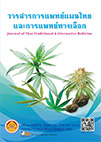A Comparison of Herbal and Water steam Bath's Efficacies on Sleep Qualities in Menopausal Women with Insomnia
Main Article Content
Abstract
Rationale and Objective: Insomnia is a major problem in menopausal women. This studyaimed to compare sleep qualities in menopausal women who had used herbal and water steam baths.
Methodology: This quasi-experimental research study was conducted in 30 menopausal women who had insomnia. A questionnaire on sleep quality was distributed to each of all participants for completion before and after experiment. The differences between groups were analysed by using One-way ANOVA and Paired t-test.
Result: The menopause women after receiving herbal steam had significantly better average score of sleep quality than the water steam group (p < 0.001). When compare with the control group, the herbal and water steam groups had significantly better average scores of sleeping
quality than the control group (p < 0.001). Following the comparison before and after experiment, the herbal and water steam groups had better sleeping quality (p < 0.001), while the control group had not found the significant difference. Discussion and Conclusions: Herbal steam baths can help menopausal women get better sleep qualities than only water steam bath. Thus, health-care facilities should promote herbal steam bath as an alternative method for increasing sleep quality in menopausal women with insomnia.
Article Details
References
2. มลฤดี ประสิทธิ์, ชวนชม สกนธวัฒน์, เกสร เหล่าอรรคะ, สุกรี สุนทราภา, ศรีนารี แก้วฤดี, วรลักษณ์ สมบูรณ์พร, และคณะ.อาการของสตรีวัยหมดประจำเดือน ที่มารับบริการที่คลินิกวัยหมดประจำเดือนโรงพยาบาลศรีนครินทร์.ศรีนครินทร์เวชสาร. 2550;22(3):267-74.
3. นิมิต เตชไกรชนะ, กอบจิตต์ ลิมปพะยอม. การเปลี่ยนแปลงในวัยหมดระดู. ใน: นิมิต เตชไกรชนะ(บรรณาธิการ). ฮอร์โมนทดแทนในสตรีวัยหมดระดู. พิมพ์ครั้งที่ 1.กรุงเทพฯ: ภาควิชาสูติศาสตร์และนรีเวชวิทยา คณะแพทยศาสตร์ จุฬาลงกรณ์มหาวิทยาลัย; 2543. หน้า137-66.
4. อรรณพ ใจสำราญ, กอบจิตต์ ลิมปพยอม. อาการและอาการแสดงของสตรีวัยหมดประจำเดือน.ใน: กอบจิตต์ ลิมปพะยอม (บรรณาธิการ). วัยหมดระดู. พิมพ์ครั้งที่ 1.กรุงเทพฯ: สำนักพิมพ์กรุงเทพเวชสาร; 2543. หน้า 80-4.
5. กรมสุขภาพจิต กระทรวงสาธารณสุข. รู้จักรู้ใจวัยทอง. บทความสุขภาพจิตและจิตเวช.กรมสุขภาพจิต กระทรวงสาธารณสุข [ออนไลน์]. 2547กรกฏาคม.[26 ธันวาคม 2557];[2 หน้า].ที่มา:http://www.dmh.go.th/news/view.asp?id=558
6. กรมสุขภาพจิต กระทรวงสาธารณสุข. อาการของหญิงวัยทอง. บทความสุขภาพจิตและจิตเวช. [ออนไลน์].2547 กุมภาพันธ์ [17 มกราคม 2558];[2หน้า].ที่มา:http://www.dmh.go.th/news/view.asp?id=604.
7. สำนักสารนิเทศ. กระทรวงสาธารณสุข. สธ.เผยสตรีวัยทองเกือบครึ่ง มีปัญหาโรคเรื้อรัง แนะให้ยึดหลักปฏิบัติตัว 3อ. 2 ส. 1 น. ข่าวเพื่อสื่อมวลชน.[ออนไลน์]. 2557 ตุลาคม. [5 พฤศจิกายน 2557];[2 หน้า].ที่มา: http://pr.moph.go.th/iprg/include/admin_hotnew/ show_hotnew.php?idHot_new= 68543. 2557
8. Chong, Y., Fryar, C.D. and Gu, Q. Prescription seep aid use among adults: United States, 2005–2010; NCHS Data Brief. U.S. Department of health and human services; Centers for disease control and prevention national, Center for health statistics [internet]. No.127, 2013Aug. [cited2015 Jan 3]; (8 pages). Available from: http://www.cdc.gov/nchs/data/databriefs/db127.pdf
9. กรมพัฒนาการแพทย์แผนไทยและการแพทย์ทางเลือก. คู่มือการดูแลสุขภาพด้วยการแพทย์แผนไทยและการแพทย์ทางเลือก. พิมพ์ครั้งที่ 1. กรุงเทพฯ: กองทุนภูมิปัญญาการแพทย์แผนไทย;2554.หน้า 1-331
10. Buysse, D.J. Chapter 1 Introduction. In Buysse, D.J., Sleep disorders and psychiatry (review of psychiatry series, Volume 24, Number 2; Oldham JM and Riba MB, series editors. 1st ed.Washington, DC: American Psychiatric Publishing;2005. p.1-28.
11. กรมสุขภาพจิต กระทรวงสาธารณสุข. แบบประเมินความเครียด (ST5)[ออนไลน์].2554 กรกฎาคม[18 มกราคม 2558]; [1 หน้า]. ที่มา: http://www.dmh.go.th/test/qtest5/
12. Buysse FJ, Reynolds CF, Monk TH, Berman SR, Kupfer DJ. The Pittsburgh Sleep Quality Index: a new instrument for psychiatric practice and research. Psychiatry Res. 1989;28:193–213.
13. ตะวันชัย จิรประมุขพิทักษ์, วรัญ ตันชัยสวัสดิ์.ปัญหาคุณภาพการนอนหลับของพยาบาลประจำการโรงพยาบาลสงขลานครินทร์. วารสารสมาคมจิตแพทย์แห่งประเทศไทย.2540;42:123-32.
14. Sitasuwan T, Bussaratid S, Ruttanaumpawan P, and Chotinaiwattarakul W. Reliability and Validity of the Thai Version of the Pittsburgh Sleep Quality Index.JMedAssoc Thai.2014:97 Suppl 3.S57-67.
15. กุณฑลี จริยาปยุกต์เลิศ,เวทิส ประทุมศรี. ผลการใช้น้ำมันหอมระเหยลาเวนเดอร์ต่อการนอนไม่หลับในผู้ป่วยโรคซึมเศร้า. วารสารสาธารณสุขมหาวิทยาลัยบูรพา. 2549;1(1):47-51.
16. รัชนีกร ใจคำสืบ. ผลของโปรแกรมพยาบาลสนับสนุนและการให้ความรู้ร่วมกับการเดินออกกำลังกาย ต่ออาการเหนื่อยล้า นอนไม่หลับและวิตกกังวลของผู้ป่วยมะเร็งเต้านมที่ได้รับเคมีบำบัด. วารสารโรคมะเร็ง.2552;29(4):152-61.
17. จรียา เขี้ยวผึ้ง, ลดาวัลย์ อุ่นประเสริฐพงศ์, นิชโรจน์ ประคอง อิทรสมบัติ,อรพิชญา ไกรฤทธิ์. ผลการนวดกดจุดฝ่าเท้าต่อคุณภาพการนอนหลับในผู้สูงอายุที่มีภาวะนอนไม่หลับ. รามาธิบดีพยาบาลสาร.2554;17(1):90-107.
18. เพชรน้อย สิงห์ช่างชัย, อรุณพร อิฐรัตน์, เพ็ญนภา ทรัพย์เจริญ,ปราณี รัตนสุวรรณ. ต้นทุนและผลการอบไอน้ำด้วยสมุนไพรต่อการบรรเทาความเจ็บปวดของผู้ป่วยเอดส์ที่มารับการรักษาในวัดแห่งหนึ่งในภาคใต้. สงขลา: มหาวิทยาลัยสงขลานครินทร์ วิทยาเขตหาดใหญ่; 2542.(54 หน้า).
19. ศิรินทิพย์ คำฟู, พนิดา หาญพิทักษ์พงศ์, ใหม่ทิพย์ สิทธิตัน, พลากร อุดมกิจปกรณ์, ณัฐพล วงค์คำแดง, ดวงกมล ศรีสังข์, และคณะ. การเปรียบเทียบผลของการอบไอน้ำสมุนไพรและการอบไอน้ำธรรมดาต่อความยืดหยุ่นของร่างกาย. ศรีนครินทร์เวชสาร. 2558;30(6):592-97.
20. Mooventhan A and Nivethitha L. Scientific evidence-based effects of hydrotherapy on Various Systems of the body. N Am J Med Sci. 2014;6(5):199-209


